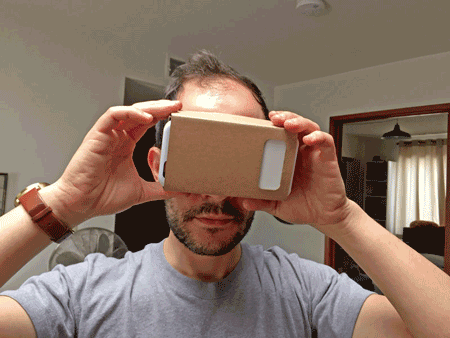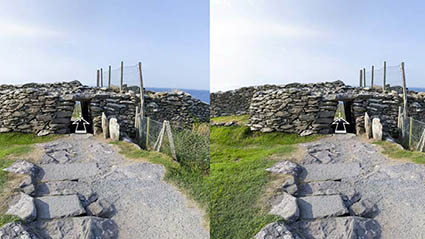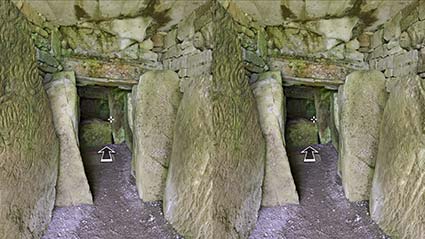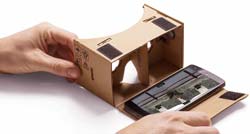Head Mounted Display
for Virtual Reality
The invention of [photography] gives a new life and a new meaning to the study of Archaeology. The very best drawing is infinitely inferior to the realities of any building, and many of the most interesting questions may hang on what no draughtsman’s skill can give…Now all these things come within the range of photography…1
The Kent Archaeological Society passed the above resolution in 1858, just a couple of decades after the invention of photography. It would be 150 more years before the new art entered the realm of fully immersive virtual reality, allowing users on this site who have a head mounted display (HMD) to “enter into” the ancient monuments using the latest in the technology of verisimilitude.

With your smartphone and Google Cardboard you can enjoy a private tour of some of the ancient monuments featured on this site.
While the HMD is still in its infancy, the acquisition of Oculus Rift by Facebook in 2014 brought the attention of technologists, stock analysts, and the general public to this new frontier of mediated experience. There are now hundreds of virtual tours, 360° videos, games, and simulations available for those with the required hardware, which, for the Oculus, mandates a fast processor and robust display driver.
The conventional virtual tour, as deployed throughout Voices from the Dawn, presents the user-navigable VR tours of the different sites on the screen of a computer or tablet. The user sees this as a narrow segment of his visual environment, and must stare at the screen and interact with it by using a mouse to drive a cursor. On a tablet navigation is accomplished by dragging a finger across the display.
The head-mounted display on the other hand, completely dominates the visual field of the user. It therefore isolates her from the distractions of the actual physical environment and encompasses the entire field of view, including the peripheral space, within the mediated visual experience. Navigation is immediate and intuitive; move your head and/or rotate your body to explore the 360° virtual space. Align the crosshairs target with the arrow to advance to the next scene.
Our HMD VR tours were originally developed and tested with the Oculus Rift (DK 2). This is a rather expensive ($350 / €330) solution, and, as stated on the Oculus website: “…this hardware is intended for developers and it is not a consumer product.” The consumer version of the Oculus is due to be released in the summer of 2015. If you should happen to own an Oculus Rift, you will be able to access our HMD tours using a special beta web browser called Firefox Nightly, with the MOZVR plug-in installed. You can download both the browser and the plug-in here.
There are other HMD hardware solutions that are or will soon be available, such as Sony’s “Project Morpheus,” the HTC “Vive,” and the Microsoft HoloLens. These have not been tested with our HMD tours.
In a move calculated to bring the HMD VR experience to the masses, Google introduced in 2104 a simple fold-along-the-dotted-line solution, called Google Cardboard. This is not a complete HMD, with its own twin LCD screens. With Google Cardboard, your own smartphone becomes the display screen. See the FAQ below for a list of compatible smartphones. You can download from Google a hardware list and a template that will enable you to assemble your own device from easily obtainable materials. Or you can purchase, as we did, a packaged kit with everything included, for around $15 / €14.
Once you have assembled your Google Cardboard, before inserting your smartphone, touch the one of the images below to enter the HMD version of that site’s virtual tour. Then touch the “Enter VR” button. Then you can place your smartphone into your Google Cardboard and explore the site. To navigate into the scene, turn your head to align the crosshairs target with the arrow.

Newgrange
If you have your head-mounted display, touch the image (above) to load the HMD Newgrange tour. Then touch the “Enter VR” button. To navigate, turn your head to align the crosshairs target with the arrow. Our full Newgrange page is here.

Stonehenge
If you have your head-mounted display, touch the image (above) to load the HMD Stonehenge tour. Then touch the “Enter VR” button. To navigate, turn your head to align the crosshairs target with the arrow. Our full Stonehenge page is here.

Dunbeg Promontory Fort
If you have your head-mounted display, touch the image (above) to load the HMD Dunbeg tour. Then touch the “Enter VR” button. To navigate, turn your head to align the crosshairs target with the arrow. Our full Dunbeg page is here.

Loughcrew Passage Tombs
If you have your head-mounted display, touch the image (above) to load the HMD Loughcrew tour. Then touch the “Enter VR” button. To navigate, turn your head to align the crosshairs target with the arrow. Our full Loughcrew page is here.
FAQ
1. Which smartphones are compatible with Google Cardboard?
2. I see two images, they are not blending together.
3. Why does my display turn off after I’ve been looking at the HMD tour for a period of time?
4. After I touch “Enter VR,” the two images on my phone are vertical, even when I rotate the phone.







